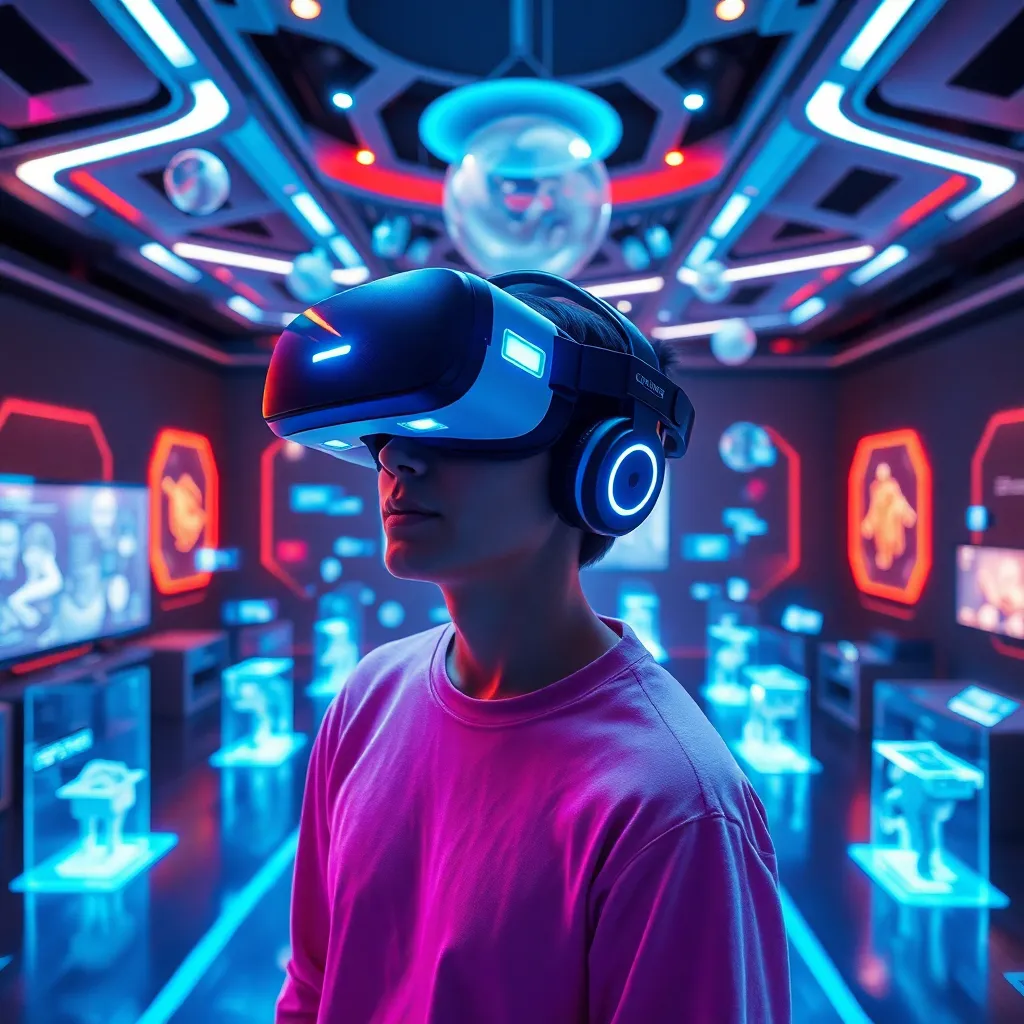The gaming revolution: virtual reality as a new era
The gaming world is on the cusp of a new era in which virtual reality (VR) is fundamentally changing the way we experience games. VR technology allows players to fully immerse themselves in digital worlds and interact with them as if they were actually there. This development promises to take the gaming experience to a whole new level and opens up unimagined possibilities for developers and players alike.
Advances in VR technology
VR technology has made enormous progress in recent years. The latest VR headsets offer high-resolution displays, precise motion tracking and a wide field of view that provides a convincing sense of presence in the virtual world. Devices such as the Oculus Quest 2 and PlayStation VR2 have established themselves as leaders in the market, setting standards in terms of performance and ease of use. At the same time, VR devices are becoming lighter and more comfortable, allowing for longer gaming sessions without users suffering from fatigue or discomfort. Improved battery life and wireless technologies also contribute to user-friendliness.
VR in simulation games: A new level of immersion
One area where VR particularly shines is simulation games. Whether it's piloting an airplane, flying a spaceship or driving a race car, VR offers a level of immersion and realism that can't be achieved with traditional screens. Players can turn their heads to look out the cockpit window or use their hands to operate virtual switches and levers, providing an unparalleled sense of control and presence. Games such as "Microsoft Flight Simulator" in VR allow players to enjoy realistic flying experiences, while racing games such as "Project Cars VR" offer an authentic driving experience.
Action and adventure games in virtual reality
Action and adventure games also benefit enormously from VR technology. Titles such as "Half-Life: Alyx" have shown how VR can be used to create intense, immersive experiences where players can physically interact with their surroundings. Aiming a gun, opening doors or solving puzzles feels more natural and intuitive in VR than ever before. This interactivity increases player excitement and engagement, making every game a unique experience.
Social interaction in the virtual world
Another exciting aspect of VR gaming is the social experience. Multiplayer VR games allow friends to meet up in virtual spaces and go on adventures together, regardless of where they are in the real world. Platforms such as VRChat offer a wide range of opportunities for social interaction, from simple meet-ups to complex games and events. This form of social interaction can be particularly valuable in times when physical meetings are not possible, creating new ways of connecting and sharing experiences.
Challenges for developers in VR gaming
The development of VR games presents developers with new challenges, but also offers countless opportunities for innovation. Design decisions that work in traditional games often need to be rethought for VR. Movement, interaction and user interfaces must be designed in such a way that they appear natural and intuitive in virtual reality. In addition, optimizing for different VR platforms requires extensive testing and adjustments to ensure a consistent and high-quality experience.
Potential for improvement: Haptic feedback and more
One area in which VR gaming still has room for improvement is haptic feedback. While current controllers already offer vibrations and basic tactile sensations, researchers and developers are working on more advanced systems to provide an even more realistic feel for virtual objects and surfaces. Technologies such as haptic gloves and full-body suits could further deepen immersion and revolutionize physical feedback in VR experiences.
The future of VR gaming: Innovations and trends
The future of VR gaming looks promising. With the continuous improvement of hardware and the growing experience of developers in using the medium, we can expect even more immersive and innovative VR experiences in the coming years. Technologies such as eye-tracking and advanced AI systems could make VR games even more realistic and responsive. Eye-tracking allows for more precise interaction and realistic gaze control, while AI-powered NPCs provide more dynamic and intelligent reactions.
Mixed reality: the fusion of real and virtual
Developments in the field of mixed reality (MR), in which virtual elements are integrated into the player's real environment, are particularly exciting. This could lead to completely new game concepts in which the boundaries between the virtual and real worlds become blurred. Applications such as Microsoft's HoloLens are already demonstrating the potential of MR by seamlessly integrating virtual objects into the physical environment, creating hybrid experiences that can be used both at home and on the move.
VR in e-sports and competitive gaming
VR could also play a greater role in e-sports and competitive gaming in the future. VR tournaments, in which players not only have to prove their strategic skills but also their physical dexterity, could open up a new dimension of competition. By integrating movement and interaction into the competition, new game modes and sports are being developed that expand the traditional e-sports spectrum and appeal to new target groups.
Educational opportunities through VR gaming
The educational possibilities of VR gaming are also remarkable. Educational games in VR can teach complex concepts in an interactive and vivid way that would not be possible in traditional learning environments. From exploring historical sites to simulating scientific experiments, VR provides an immersive learning environment that can impart knowledge in a unique way. Schools and educational institutions are increasingly using VR to revolutionize learning and open up new perspectives for pupils and students.
Therapeutic applications of VR gaming
An important aspect that is often overlooked is the potential therapeutic application of VR gaming. Studies have shown that VR gaming can be helpful in the treatment of phobias, PTSD and other mental health conditions. The immersive nature of VR allows therapists to create controlled environments in which patients can safely confront their fears. In addition, VR experiences can be used for rehabilitation and pain management by supporting patients through immersive distraction techniques.
Challenges and barriers for the VR market
Despite the enormous potential, there are also challenges to overcome. The cost of high-quality VR equipment is still relatively high, which is a barrier for many potential users. In addition, VR systems often require a lot of space and powerful hardware, which is not practical for every household. However, the industry is working to overcome these barriers by developing more affordable and user-friendly solutions. Initiatives to reduce production costs and improve accessibility could further drive the uptake of VR gaming.
Combating VR disease: progress and solutions
Another important aspect is combating the so-called "VR sickness", a form of motion sickness that some users experience when playing VR games. Developers are experimenting with various techniques to minimize this problem, such as using static reference points or adjusting the speed of movement. Advances in hardware, such as higher refresh rates and improved sensors, are also helping to reduce VR sickness and make the gaming experience more comfortable.
Artificial intelligence and dynamic worlds in VR
The integration of artificial intelligence (AI) into VR games is another exciting trend. AI could be used to create more dynamic and responsive virtual worlds in which NPCs (Non-Player Characters) interact with the player in a more natural way. This could lead to even more immersive and believable gaming experiences as the virtual environment intelligently adapts to the player's actions and decisions. Adaptive AI systems could also enable personalized gaming experiences that adapt to the user's individual play style and preferences.
Market development and growth potential of VR gaming
The market for VR gaming is growing steadily and is expected to expand further in the coming years. Studies forecast significant growth in the VR market, driven by technological innovations, falling prices and increasing consumer acceptance. Companies are increasingly investing in the development of VR content and platforms, leading to a greater variety of available games and applications. The growing interest in e-sports and the integration of VR into various areas of life are also contributing to the market dynamics.
The role of VR in the gaming industry
For the gaming industry as a whole, the rise of VR presents both opportunities and challenges. Developers need to learn new skills and adapt their design philosophies to create effective VR experiences. At the same time, VR opens up new markets and opportunities for innovation that have the potential to transform the entire industry. Companies that invest early in VR technologies and develop innovative content can secure a competitive advantage and benefit from the growing market opportunities.
Conclusion: VR gaming as the future of entertainment
In conclusion, while VR gaming is still in its infancy, it has the potential to fundamentally change the way we experience and interact with games. As the technology advances and adoption grows, VR could become an integral part of the gaming landscape, enabling new forms of entertainment, learning and social interaction. The future of gaming is three-dimensional, immersive and more interactive than ever before - and VR is at the forefront of this exciting development. Gamers, developers and the industry as a whole are only at the beginning of a journey that has the potential to redefine the boundaries of what is possible in gaming.





